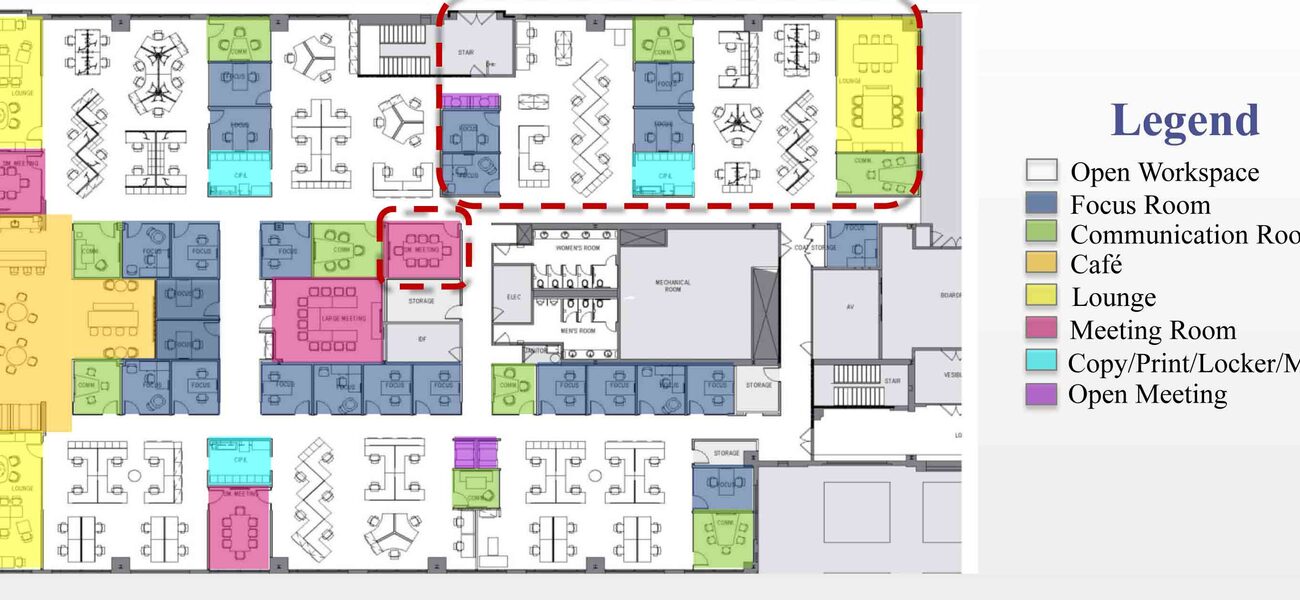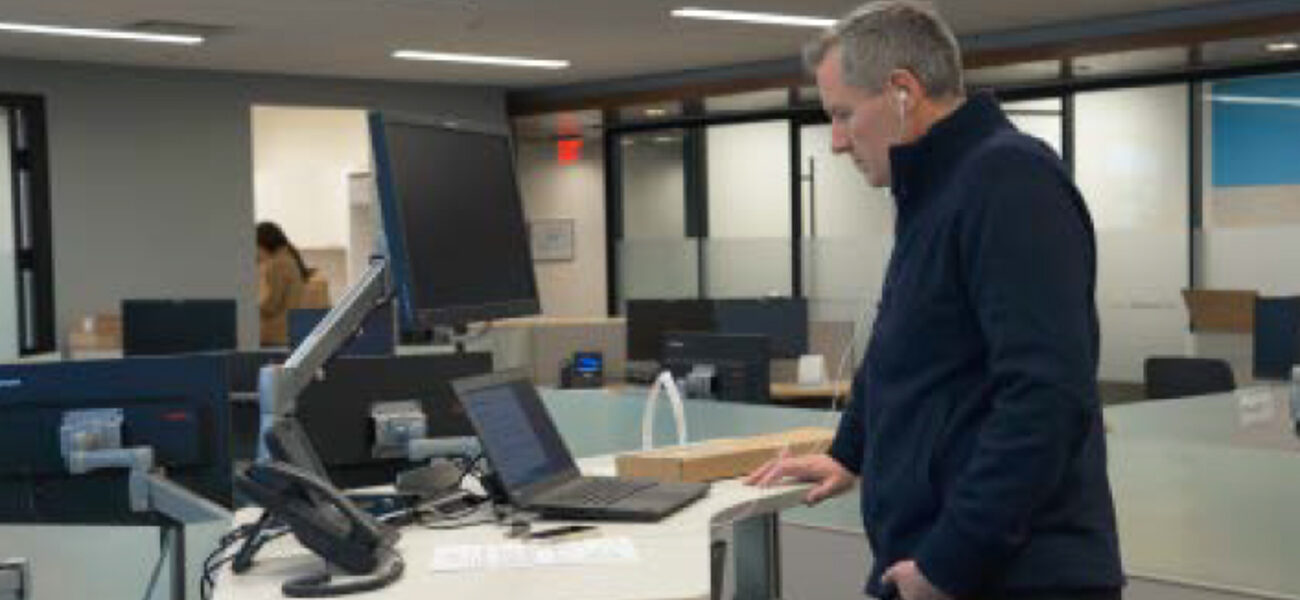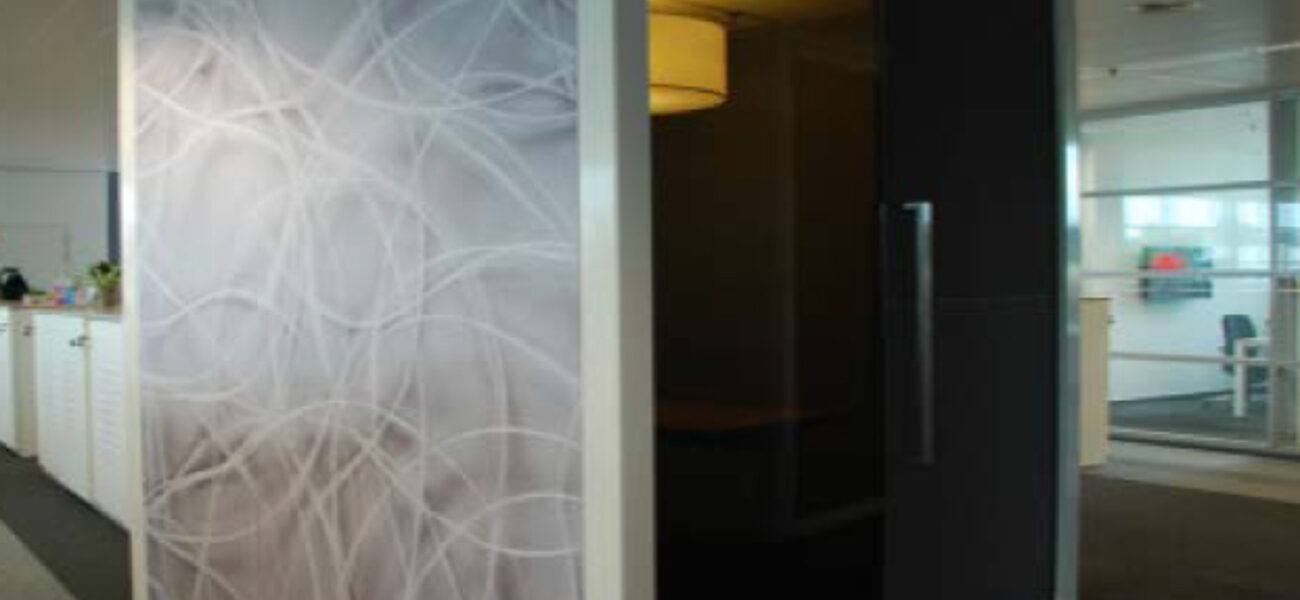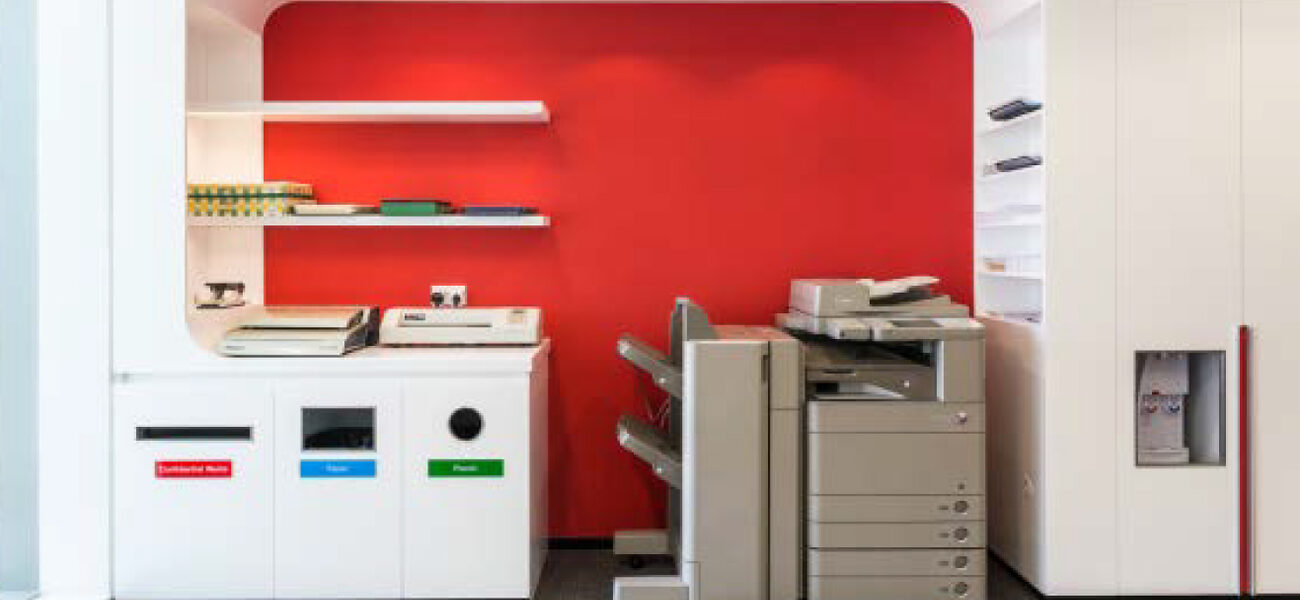After successfully launching FLEXplace—a dynamic initiative to increase employee well-being and business productivity—Johnson & Johnson further refined its activity-based planning approach and rebranded it as the “Workplace Innovation Program.” The revised program further establishes design and operating guidelines for creating collaborative and personal work environments for a wide variety of business functions in different locations and cultures around the world. Currently in use by approximately 10,000 people in multiple countries, the program will ultimately influence how more than 50,000 employees work worldwide, and ideally be applied to every large capital project that is deemed suitable at the company.
“The name change of the program to Workplace Innovation reflects a shift from focusing on external and internal mobility, to applying a broader perspective that includes speed of decision-making, flexibility, and talent retention,” says Jonathan Sheh, director of workplace experience at Johnson & Johnson. “We have recently rolled the program out in Stockholm, Kuala Lumpur, Leeds (UK), and several US locations for over 2,000 people; we also have large projects underway in Shanghai, São Paulo, and Tampa Bay that will benefit more than 4,000 workers. The pace at which we are deploying this change is both exciting and challenging.”
As an activity-based model, the program is not designed around a 100-percent open plan. About 20 percent of the workspaces are dedicated to closed-door focus rooms that provide exceptional audio privacy. Seating is primarily unassigned, with a maximum of 30 percent of employees allowed to be assigned to an open desk.
“It’s important to note that this is not a work-from-home program, though the Workplace Innovation program is agnostic when it comes to the practice,” says Sheh. “If a department wants to have a work-from-home policy, it does work within the program.”
Socially Sized Neighborhoods
Open-plan workspaces are built around “socially sized” neighborhoods, meaning neighborhoods that are divided into groups large enough to produce a high thought diversity yet small enough for people to easily know everyone in their neighborhood.
“We want our neighborhoods to be large enough to apply sharing ratios and provide the full variety of work settings, while staying small enough to enable the feeling of being one group,” says Sheh.
A group size of 10 is considered too small for the required intellectual diversity, while a group size of more than 100 becomes unwieldy. As a result, the program targets group sizes of around 70 people.
“We’ve found that this size is large enough for true diversity and manageable enough for real social interaction,” says Sheh.
Each neighborhood also features lounges that allow for some level of end-user customization, and a neighborhood meeting room that seats up to 10 people.
“In a traditional work environment, we would have one meeting or collaboration seat for every six to seven work seats. Our ratio is now about seven times that,” says Sheh. This re-allocation of space is important to align with the demand that business puts on space today.
Overall, there are about 25 alternative work settings that could be used on any given day, with a wide range of variations for ergonomics, technology, closed versus open environments, and collaborative teamwork versus individual focused work.
Concrete vs. Clay
Creating a global space planning program means balancing clear standards and guidelines with flexible elements that can be adapted based on regional culture and business application. As a result, some elements of the Workplace Innovation Program are considered “concrete,” while others are more moldable “clay.” Some elements are considered “grey” and can be interpreted on a case-by-case basis, depending on regional differences.
Among the concrete elements is an established sharing ratio of 1:2 at move-in, which is similar to sharing ratios at other companies.
“The reason for a 1:2 sharing ratio at move-in is that, if you go too low, people just go to the same desk and continue the behaviors they had before. If you go too high in your sharing ratio, you create a land grab, where people put their stuff somewhere and try to hold on to it. What we’re really after is about 75 percent active utilization, ‘active’ meaning there is actually a person there, not just their stuff,” says Sheh.
To keep space active and avoid land grabs, most desk storage has been eliminated, and personal storage is placed around the office space in designated areas. In addition to dedicated file storage, employees have access to personal lockers with USB and power connections, where they can securely store and charge devices.
Unassigned focus rooms replace offices, allowing for one person to sit alone and do concentrated work. Dedicated working cafés are shared between two to three neighborhoods. These are a valuable social setting and are increasingly used for a variety of work activities during the day. Shared printing and supply areas are supported with FollowMe® and HotSpot (proximity) printing applications that allow items to be printed at any printer. Documents are retrieved only after someone has scanned their badge.
Another element considered concrete is the quality of space, including key features like acoustics.
“Whatever the space, if it’s going to be part of the Workplace Innovation Program, we are going to hold it to the same standard of quality. But what our program dictates is performance, not how you get there. While all of our spaces achieve the same acoustical quality, they each get there in somewhat different ways, depending on whether it’s in the U.S., Asia, or Europe,” says Sheh.
Clay elements include regional variations for things like soft seating, branding, and personalization. Grey elements include executive assignment, ergonomic solutions, and technology options.
Constant Drive for Improvement
Now in its fifth year, the program is constantly revising and improving to better meet initiative goals. A number of lessons have been learned over multiple implementations. One issue that became apparent is the challenge of managing acoustics in unassigned focus spaces.
“We’ve found that when a closed space is unassigned, the acoustics need to be better than when it is assigned. This is because—like living next to the train tracks—you get used to chatter in the next office when it’s there every day. But if there is a different person there every day, and one has a booming voice while another has a quiet voice, it can be very distracting when you’re trying to focus,” says Sheh.
Neighborhood lounges have also been identified as an area with potential for improvement.
“We wanted the lounges to do several things exceptionally well, including meetings, focus work, and hosting social events. But we haven’t established the proper mix of furniture to really achieve this. We are however allowing for a great deal of user flexibility with the lounges, so that might bring some unanticipated brilliance,” says Sheh.
Pre- and post-occupancy surveys are conducted when rolling out the program to gather user data on what is being done well and what isn’t. Based on post-implementation surveys, the program recently implemented in Titusville, N.J., delivered some of the most impressive results to date. In pre-project surveys, only 37 percent of occupants felt that the atmosphere fostered innovation, while 64 percent of occupants felt that way post-project. Even more impressive was the shift from the number of people who could find meeting rooms when they needed them, which went from 38 percent pre-project to 92 percent.
“That shift made me nervous because we had to trade something for that, right? But people’s ability to focus also went up from 51 percent to 85 percent. So we believe the program is moving things in the right direction” says Sheh.
One thing the team unexpectedly discovered as a result of the survey was a difference in the user experience based on gender. Females said that functionality and the ability to have spontaneous conversations went up, while it was already high among men and didn’t change much. When asked if having an assigned office indicated if they were more ahead in their careers, the men still felt that it does, while women largely did not.
“I don’t know what we’re going to do with this information. It’s new. But we are looking at it and considering if what we do in the workplace can play a role in balancing any gender inequality,” says Sheh.
Change Implementation
One of the important things discovered in developing the change implementation strategy was to not let leaders explain the program.
“The problem is that they never get it right. The functional details are not their expertise. But we’ve found that it’s useful to have leaders explain why we’re doing this. We ask them to do it without a PowerPoint or bullet lists, but with a personal story about what has changed in the world. We’ve found that to be one of the best ways to communicate why this is important for the business to do,” says Sheh.
Another key to successful implementation is adapting to the regional style of leadership.
“If leadership is very hierarchical, like it is in parts of Latin America, you may need to adjust your change program a bit. In the U.S., we use a lot of ambassadors who are people at lower levels in the organization. In parts of Latin America, they want it to cascade. So we adapt to that,” says Sheh.
Making an effort to engage people on their own terms and create direct feedback loops has also proven successful.
“Some teams are under intense pressure to produce to a deadline, and we cannot add more meetings to their calendars, so we go a little old school in our approach: We come to your space; we buy you breakfast. Every week we put out three new posters. We collect massive amounts of feedback. We really try to make it easy for you to give us the information we need,” says Sheh.
The combination of a concrete program foundation, malleable elements, awareness of the business, and a continuous improvement mindset has created a program that Johnson & Johnson believes to be a differentiating factor for their workforce.
By Johnathon Allen



